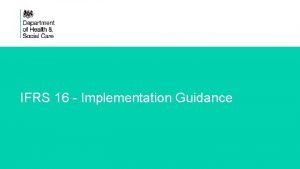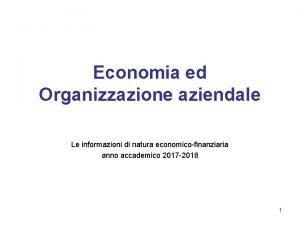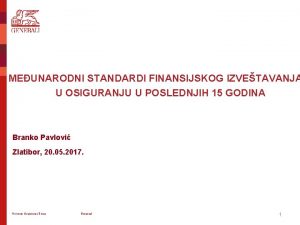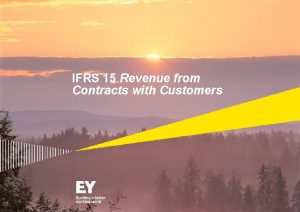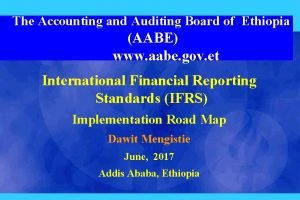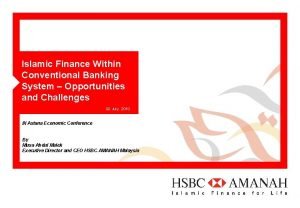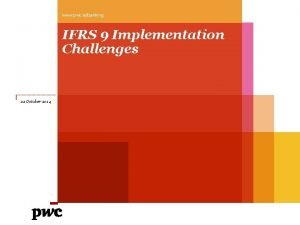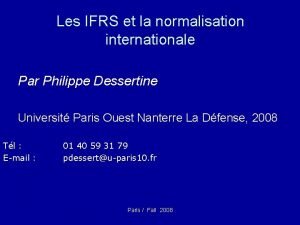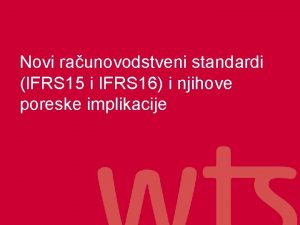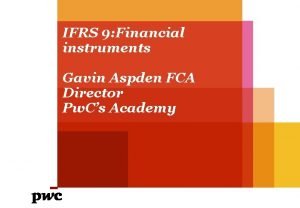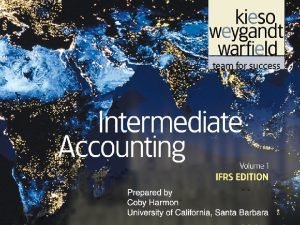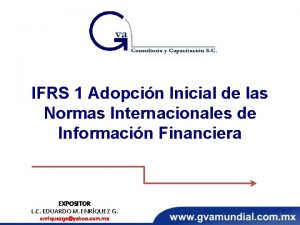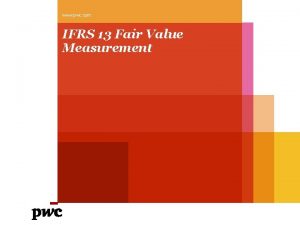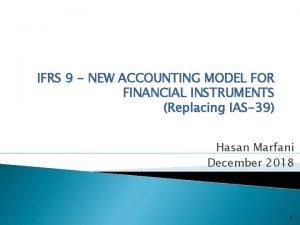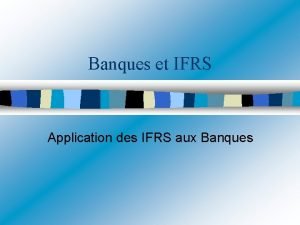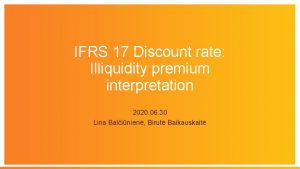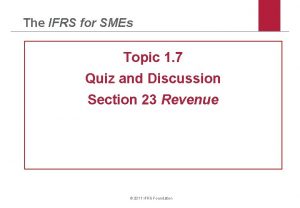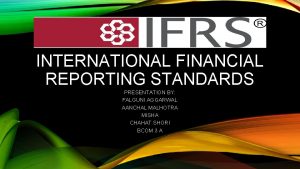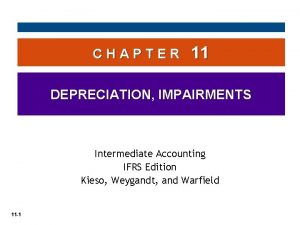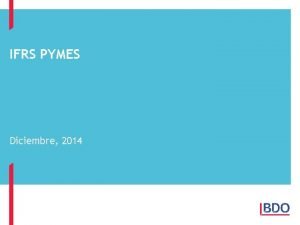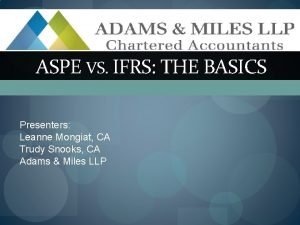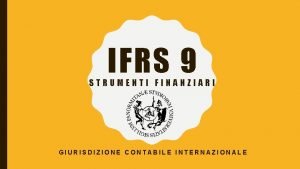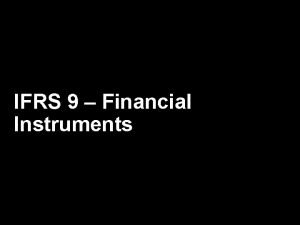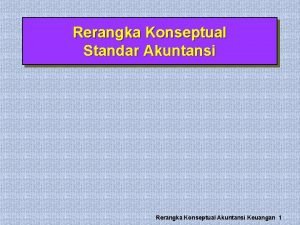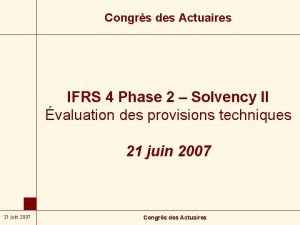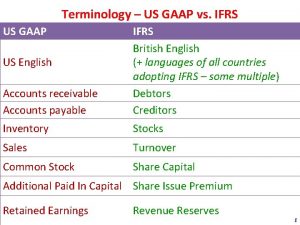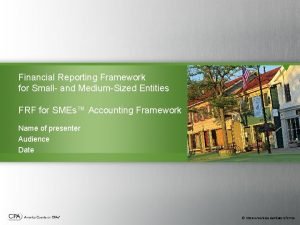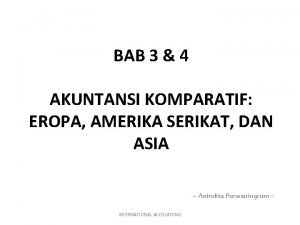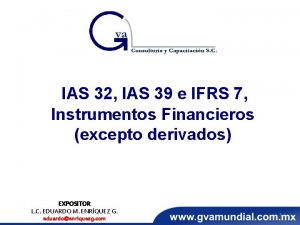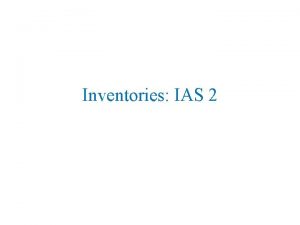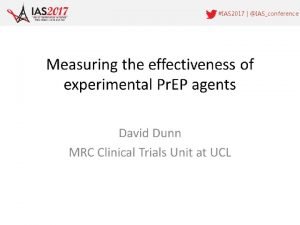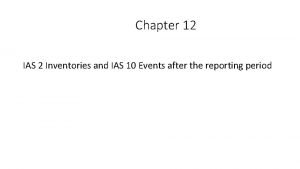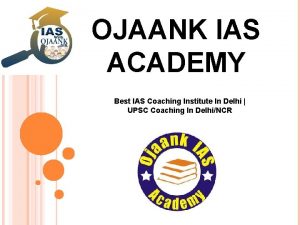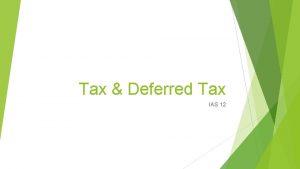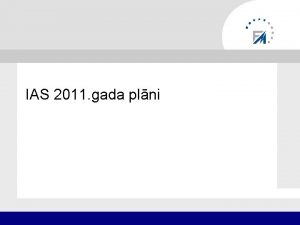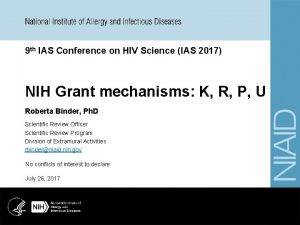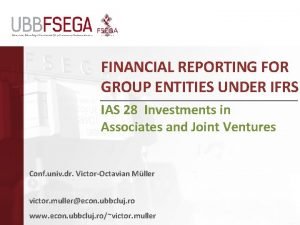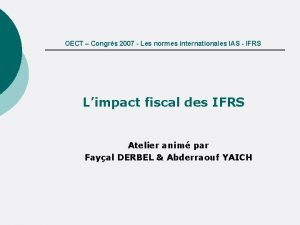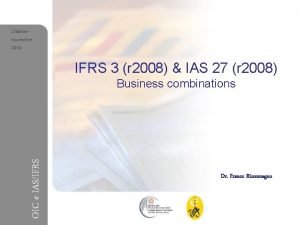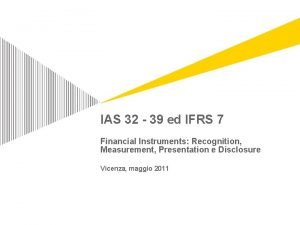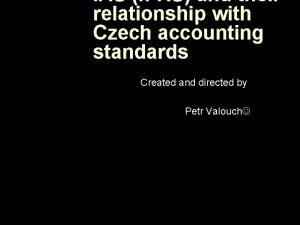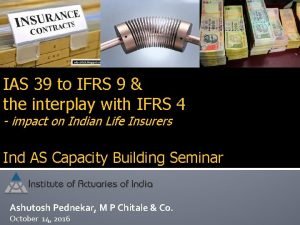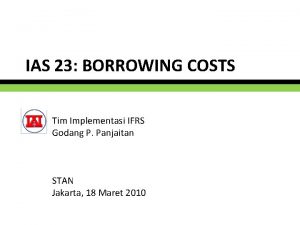From IAS 39 to IFRS 9 An overview
































- Slides: 32

From IAS 39 to IFRS 9 An overview Pascal Frèrejacque, Sr. Operations Officer

Introduction » 2 constraints for the IASB when preparing a new accounting standard ‒ Ensure transparency ‒ Support for stability/limit pro-cyclicality » Closer to the provisioning objectives of banking regulators » IASB decided towards a risk model better aligned with banks credit management systems » Which addresses partially pro-cyclicality concerns » Challenges to address the financial instruments impairment issues does not favor timeliness (2009 -2018) 2

Transparency From IAS 39 to IFRS 9: Loan Loss Provisioning – A dual perspective Jan 2018 Expected loss IASB Incurred losses (IAS 39) Jan 2005 Pre-IFRS impairment model in the EU Stability 3

The IFRS 9 project

Objective of the new standard Replace IAS 39, a very rule based standard that was difficult to understand, apply and interpret… With a less complex, more principle based standard Have the standard converge with the US GAAP Respond to the April 2009 call of the G 20 and the recommendation of the FSB 5

IFRS 9 – The IASB financial instrument project A complicated project: - 3 phases - Issued in four ‘pieces’ over a 5 years period - 4 Exposure Draft - 9 years to implement a change: 2009 -2018 A challenging context: - Changing regulatory environment - Convergence with US GAAP - Very technical issues with huge implication in terms of equity and P&L for banks 6

The IFRS 9 project Phase 1: Classification and measurement IFRS 2010 2011 2012 2013 2014 S 1 S 2 ED Limited amendments Phase 2: Impairment Phase 3: Hedge accounting ED ED 2016 2017 Mandatory application as of 01/01/2018 Own credit risk amendment IFRS 2015 IFRS 9 EU Endorsement? 2009 ED IFRS 7

Date of mandatory application

Date of first application of IFRS 9 In 2013, European banks were asked at a conference organized by a major accounting firms, how much time would they require to implement the IFRS proposals? 1. 2. 3. 4. 5. 6. 7. 0– 1 years 1– 2 years 2– 3 years More than 3 years Does not apply I do not know 52 28 14 7 1 2 3 4 6 8 5 6 9

Date of first application of IFRS 9 First date of application is now January 1, 2018 (was 2015) For EU countries IFRS 9 need to be endorsed by the European Commission • No official endorsement date announced yet (EFRAG Website TBD) • EU banks expect IFRS 9 endorsement during 2016 Earlier versions of IFRS 9 can be used for non Banks that are in non EU member states (classification and measurement) 10

Business Model – Central feature of IFRS 9

Introduction of business model/strategy IFRS 9: 3 business models - Held to collect contractual cash flows (amortised cost) FVPTL: Fair Value Through Profit and Loss Mixed model: FVOCI: Fair value Through Other Comprehensive Income BM is decided by management 12

Business model (continued) Do not satisfy Contractual cash flow characteristics Sa al u sidgory e R te ca tis fy FVPL Business model Hold to collect Both hold to collect and sell Amortised cost FVOCI Reclassification applies to all business models 13

Classification & measurement Impacts on loans and bonds: business model Amortized cost : a unique objective “hold to collect” - Significant sales must be infrequent (e. g. unanticipated/stress case) - Frequent sales must be insignificant both individually and in aggregate - Some exceptions: e. g. sales due to deterioration in credit quality in line with a documented investment policy An entity should not consider every ‘what if’ or worse-case scenario Unanticipated sales : - No restatement of prior period financial statements; nor change in the classification of the remaining financial assets in the business model - As long as the entity considered all relevant and objective information for initial classification Liquidity portfolios : - The portion held for extreme stress scenarios may be classified as amortized cost - But significant or frequent sales are incompatible with amortized cost (even if the sales are imposed by regulators to demonstrate liquidity) Mixed Business model « originate to hold and / or distribute » - Granularity of the analysis is key (identification of sub-portfolios) 14

Classification & measurement Impacts on loans and bonds: business model FVTOCI : a mixed objective “hold to collect AND sell” - No threshold for frequency or amount of sales - Key Performance Indicators for FVOCI are contractual interest yield, impairment charges and fair value changes - Examples : • A bank holds financial assets to meet its everyday liquidity needs. The bank typically holds some financial assets to collect contractual cash flows and sells others to reinvest • An insurer holds financial assets in order to fund insurance contract liabilities. The insurer also undertakes significant buying and selling activity to rebalance the portfolio of financial assets Trading assets + assets managed and assessed at FV should be classified at FVTPL Reclassification are prohibited - Unless fundamental change in Business Model (very infrequent) - That would generally be the case only when the entity has acquired or disposed of a business line. 15

Measurement and Classification

Classification & measurement: overview IAS 39 Held-to-Maturity (bonds) ASSETS Loans & receivables Available-For-Sale (Equites & bonds) Fair Value Option LIABILITIES Trading Fair Value Option Trading Measurement Amortised cost (with split accounting) Fair Value / OCI recyclable (with split accounting) Measurement categories New classification criteria Categories IFRS 9 Amortised cost Fair Value / OCI recyclable (loans & bonds) Fair Value / OCI non-recyclable (measurement option for equities) Fair Value / P&L Amortised cost (FVO: own credit-risk in non-recyclable OCI) Amortised cost 17

IFRS 9 –criteria for classification and measurement Derivatives Loans and debt securities ‘Contractual cash flow characteristics’ test instrument level) (at Fail No Pass FVOCI option elected ? ‘Business model’ test (at an aggregate level) Hold to collect contractual cash flows 1 2 BM whose objective results in both, collecting contractual cash flows and selling Conditional FVO elected? No Amortised cost Equity 3 Yes Neither (1) nor (2) Yes No FVOCI (with recycling) FVTPL FVOCI (no recycling) 18

Impacts on equity Equities under IFRS 9: default is FVTPL Option to record fair value changes through OCI, with no recycling of gain/loss on disposal - Irrevocable choice on an instrument by instrument basis at initial recognition, if not held for trading - Only dividends are recorded in profit or loss - Extensive disclosures AFS Impairment rules – no longer relevant (‘significant and prolonged’ goes away) 19

IFRS 9 – Fair Value Measurement Hierarchy Level 1 - Quoted prices - “The best evidence of fair value is quoted prices in an active market” Level 2 – Valuation technique making maximum use of maximum of market inputs observable inputs - Reference to the current fair value of another instrument that is substantially the same, discounted cash flow analysis, and option pricing models - Valuation technique commonly used by market participants and demonstrated to provide reliable estimates of prices obtained in actual market transactions Level 3 – Valuation technique with no market observable input 20

Impairment

IFRS – Financial Instrument Impairment Model IAS 39 Incurred loss model IFRS 9 Expected loss model Current model until 2018 Impairment loss only Future model from 2018: expected loss Losses expected as a result of future events, no matter how likely are not recognised Responsive to changes in information that impact credit expectations recognised when: trigger (loss) event occurs and impact can be reliably estimated More than one model depending on classification Expected loss at recognition approach Deterioration in credit quality leads to recognition of lifetime losses Robust disclosures to support principle and support comparability 22

Summary of expected credit loss model: general model Initial recognition (with exceptions) Allowance 12 month Expected Loss (remeasured subsequently) Lifetime Expected Loss (remeasured subsequently) The credit risk has increased significantly since initial recognition (whether on an individual or portfolio basis) Criterion + Objective evidence of impairment Interest revenue based on: • • Gross carrying amount Net carrying amount Change in credit risk since initial recognition Improvement Deterioration Impact on all non impaired exposures (EL 12 mois) Impact significance will depend on current provisionning model under IAS 39 (triggers and EL horizon in the impairment allowance) No impact (criteria + measure identical to IAS 39) 23

Defining and measuring 12 -month and lifetime ECL Expected loss = Present Value of Contractual CF– Present Value of CF expected to be recovered Reporting date Default date From cash-flows to reporting date From default to reporting date From cash-flows to default date Using the effective interest rate at initial recognition (or an approximation) 12 months or lifetime expected loss depending on the bucket Lifetime expected loss. L 24

Defining and measuring 12 -month and lifetime ECL Lifetime ECL = present value of all cash shortfalls expected over the remaining life of financial instrument - [ PD(year 1) x LGD + PD(year 2) x LGD + … + PD(last year) x LGD ] 12 -month ECL = the portion of lifetime ECL associated with probability of a default occurring in next 12 months after reporting date - PD(year 1) x LGD(year 1) A probability-weighted outcome Best available information Information about past events + Information about current conditions + Reasonable and supportable forecasts The time value of money 25

General Model – Significant deterioration in credit quality The magnitude of deterioration must be assessed No quantitative trigger set in the standard must be determined consistently with risk management practices Assessment of deterioration must be made on individual or portfolio basis, for items with similar risks Assessment can be made for individual counterparty 26

Impairment - Operational simplifications Threshold Investment grade Status Allowance Non-investment grade No Days Past Dues (DPD) N/A 12 -month or lifetime ? Analysis of deterioration required Days past dues are lagging indicators Use more leading indicators : - Behavioural scores - Forebearance - Negative Credit bureau data - Loan to values - Forward looking information 30 DPD 90 DPD Lifetime Significant deterioration (rebuttable presumption) - More than 30 DPD is a backstop (it should identify significant deterioration before default or objective evidence of impairment) - Use only if forward looking information is not available (neither at individual or portfolio level) - Presumption can be rebutted (if historical evidence shows no causal link between 30 DPD and significant increase in PD 27

Defining and measuring 12 -month and lifetime ECL Default To be defined consistently with an entity’s credit risk management practice Must include qualitative indicators of default (e. g. , covenant breaches) Rebuttable presumption that default does not occur later than 90 DPD Significant deterioration Assessment based on the probability of default (does not take into account the collateral) Variation of 12 M PD can be used to assess deterioration (except if does not properly reflect deterioration) Regulatory ECL models may form a basis for ECL calculations, but the measurement may need to be adjusted Modifications / forebearance Increase in risk must be assessed by reference to credit quality on origination A modification does not automatically result in improvement of the credit quality 28

Lower risk exception Allowance = 12 -month EL (automatically, no tracking of deterioration required) Credit quality must be consistent with « investment grade » Financial instruments are not required to be externally rated Not a bright-line trigger to recognize lifetime ECL 29

Conclusions

Possible impacts Context: combined impact of regulatory changes (CRDIV), AQR, IFRS changes, and fines Access to the financial market drive banks financial reporting options more that Ro. E; - European banks favor a clean slate, and are looking closely to goodwill (for impairment) and IBNR (rising) - IBNR are on the rise; part is linked to avoiding the choc of going from an incurred loss model to and expected loss model New prudential and accounting rules are pushing banks out of certain activities and favor shadow banking 31

Thank you The views expressed in this presentation do not necessarily reflect those of the Executive Directors of The World Bank or the governments they represent.
 Non lease components
Non lease components Esempio perizia rivalutazione beni impresa
Esempio perizia rivalutazione beni impresa Ifrs 17 osiguranje
Ifrs 17 osiguranje 5 step model ifrs 15
5 step model ifrs 15 Aabe ifrs
Aabe ifrs Retained earnings ifrs
Retained earnings ifrs Aaoifi vs ifrs
Aaoifi vs ifrs Ifrs 9 pwc
Ifrs 9 pwc Substance over form ifrs
Substance over form ifrs Ifrs 16 srbija
Ifrs 16 srbija Modle ifrs
Modle ifrs Ifrs 9 summary
Ifrs 9 summary Manakah badan as yang mirip dengan iasb
Manakah badan as yang mirip dengan iasb Ifrs20
Ifrs20 Pwc hierarchy
Pwc hierarchy Ifrs 9
Ifrs 9 Ifrs 9 application
Ifrs 9 application Ian 100 ifrs 17
Ian 100 ifrs 17 Ifrs quiz
Ifrs quiz Slidetodoc.com
Slidetodoc.com Chapter 11 depreciation impairments and depletion
Chapter 11 depreciation impairments and depletion Ifrs 17 bdo
Ifrs 17 bdo Aspe 3065
Aspe 3065 Ifrs 1 was issued in
Ifrs 1 was issued in Ifrs 9 strumenti finanziari
Ifrs 9 strumenti finanziari The conceptual framework that underlies ifrs
The conceptual framework that underlies ifrs Financial assets ifrs
Financial assets ifrs Ifrs 9 flowchart
Ifrs 9 flowchart Kerangka konseptual ifrs
Kerangka konseptual ifrs Ifrs 4 phase ii
Ifrs 4 phase ii Difference between gaap and ifrs
Difference between gaap and ifrs Ifrs vs gaap
Ifrs vs gaap Kepanjangan iasc
Kepanjangan iasc
